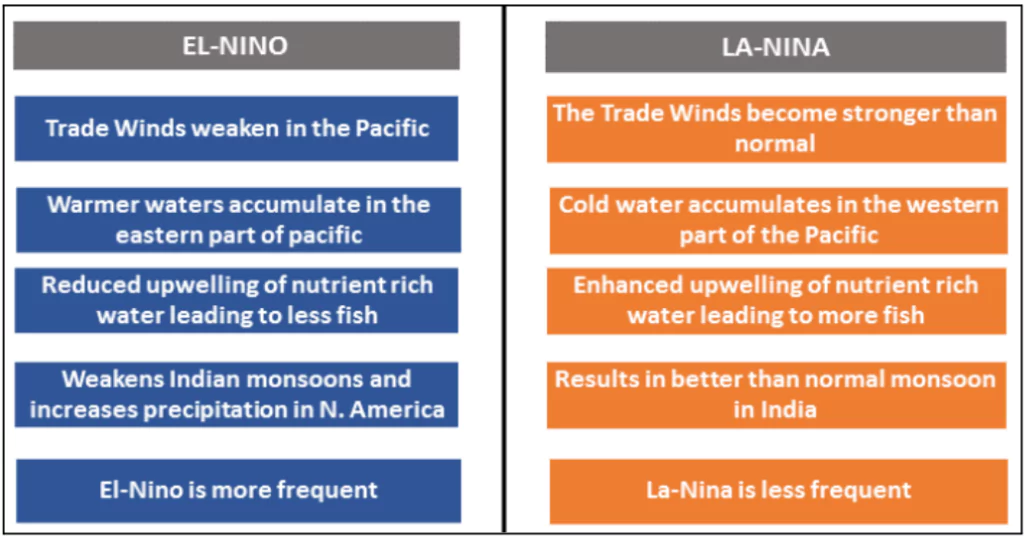The World Meteorological Organization (WMO), in its “State of Climate 2024 report” released at the UN Climate Change Conference (COP29) projects that 2024 is set to become the warmest year on record due to El Nino.
Key Findings of the State of Climate 2024 Report
- Record Global Temperatures: The January-September 2024 global mean surface air temperature was 1.54°C above pre-industrial levels, driven in part by a strong El Niño event.
- The 2015-2024 decade is likely to become the warmest decade on record.
- Despite these high short-term temperatures, long-term averages remain slightly below the 1.5°C threshold set by the Paris Agreement.
- Persistent El Niño Effects: A strong El Niño event maintained above-average global temperatures for 16 consecutive months from June 2023 to September 2024.
- Experts caution that such warming patterns contribute significantly to the likelihood of breaching critical temperature thresholds.
- Ocean Warming: Ocean heat trends, consistent with those seen in 2023, indicate that ocean warming is set to continue exacerbating climate change impacts, including altered marine ecosystems and more intense weather patterns.
- Depletion of Sea Ice:
- Antarctic Sea Ice: The annual minimum sea ice extent dropped to 2 million sq km, the second lowest since satellite monitoring began in 1979. The maximum sea ice extent was also the second lowest at 17.2 million sq km.
- Arctic Sea Ice: Although conditions were relatively better in 2024, the annual minimum was 4.3 million sq km with the maximum at 15.2 million sq km, indicative of long-term decline.
Enroll now for UPSC Online Classes
About El-Nino

- El Niño represents the warmer-than-normal phase of the El Niño-Southern Oscillation (ENSO), leading to temperature and rainfall shifts worldwide.
- Southern Oscillation: Refers to changes in air pressure over the tropical Pacific Ocean, influencing wind patterns and ocean temperatures.
- Sea Surface Temperatures (SSTs): During an El Niño event, SSTs in the equatorial Pacific Ocean near South America become warmer than the long-term average.
- Irregular Occurrence: El Niño events are not part of a regular cycle, occurring irregularly every two to seven years and are challenging to predict.
Global and Regional Impacts of El Niño
Global Impacts
- Warmer Global Temperatures: El Niño can contribute to a global increase in temperature, leading to heatwaves and other extreme weather events.
- Weakening or reversal of trade winds reduces upwelling of cold water, allowing warm water to move eastward across the Pacific.
- This increased warm water surface area further raises global average temperatures, warming the air across the Pacific and worldwide.
- Disrupted Weather Patterns: It can alter global weather patterns, causing droughts in some regions and heavy rainfall and flooding in others.
- Ocean Warming: El Niño can warm ocean waters, leading to coral bleaching and marine heatwaves, which can harm marine ecosystems.
Regional Impact

- India: Leads to weaker monsoons, with increased risk of heatwaves and drought reducing rainfall during monsoon season, impacting agriculture and water availability.
- South America (Peru Coast): Decreased fish populations due to changes in ocean currents and nutrient upwelling. It also experiences heavy rainfall and flooding in coastal regions.
- Southeast Asia: Reduced rainfall and increased risk of drought and wildfires with flooding in some regions, particularly in Indonesia and Malaysia.
- Australia: Increased risk of droughts, especially in eastern and southern Australia leading to more frequent and intense bushfires.
- North America:Heavy rainfall and flooding in California and other western states, and increased heatwaves in the southwestern United States.
Difference between El Nino and La Nina

About World Meteorological Organization (WMO)
- The World Meteorological Organization (WMO) is an intergovernmental organisation with a membership of 192 Member States and Territories.
- It is a specialised agency of the United Nations for meteorology (weather and climate), operational hydrology and related geophysical sciences.
- Origin and Establishment: The WMO originated from the International Meteorological Organization (IMO), founded in 1873. The WMO was established on 23 March 1950 with the ratification of the WMO Convention.
- Headquarters of WMO: Geneva, Switzerland
Check Out UPSC NCERT Textbooks From PW Store
Governance Structure Of WMO
- World Meteorological Congress: The supreme body of the WMO, consisting of representatives from all member states. It meets at least every four years to set general policy and adopt regulations.
- Executive Council: A 36-member body that meets annually to implement the policies set by the Congress.
- Secretariat: Headed by a Secretary-General, appointed by the Congress for a four-year term. It serves as the administrative centre of the organisation.
Reports Published by WMO
- State of the Climate Reports: These annual reports provide a comprehensive overview of the global climate, including temperature, precipitation, and extreme weather events.
- Global Climate Reports: These reports provide an assessment of the state of the global climate and its long-term trends.
- Atlas of Mortality and Economic Losses from Weather, Climate and Water Extremes: This atlas provides information on the impact of extreme weather events on human life and economic activity.
- United in Science Reports: These reports provide a scientific assessment of the latest climate science and its implications for the future.
- Global Climate Observing System (GCOS) Reports: These reports provide information on the status of the global climate observing system and its data products.
![]() 12 Nov 2024
12 Nov 2024




